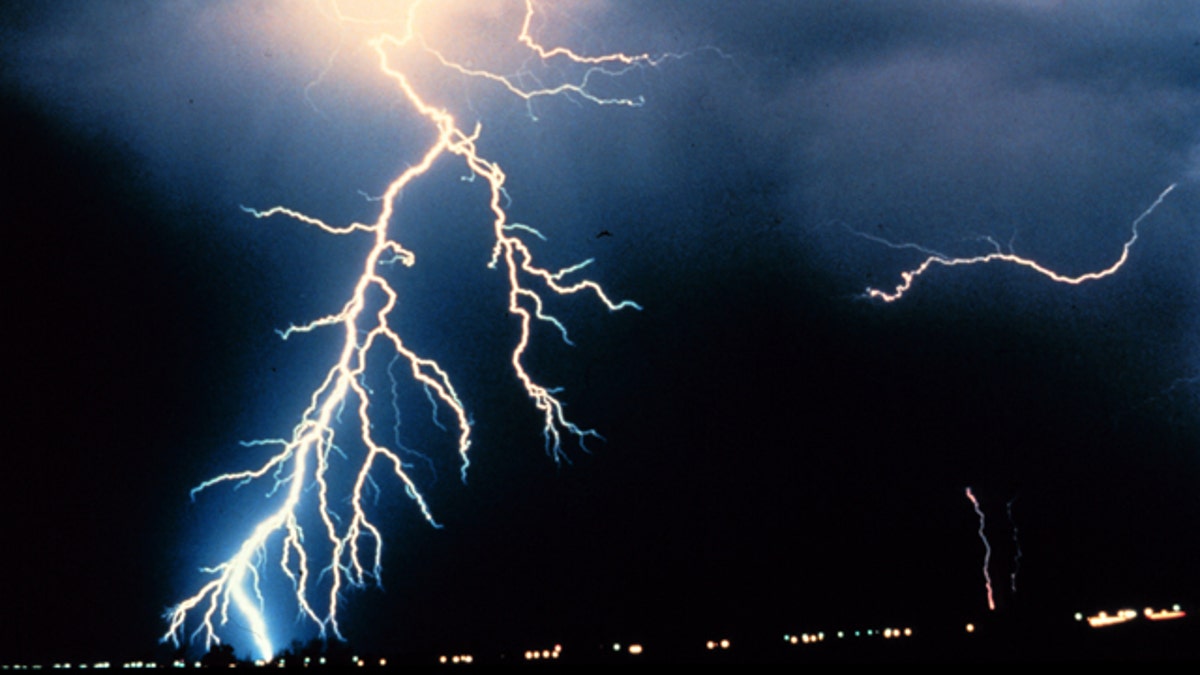
(NOAA)
Will the wandering magnetic North Pole create crazy superstorms?
The eye-popping connection between the planet's weather and its magnetic field has caught hold among scaremongers recently, ever since scientists described the potential of devastating "superstorms" -- storms caused, scientists say, by flowing gushers of water in the sky known as atmospheric rivers. Some worriers say that these tubocharged tsunamis will soon be widespread, thanks to the increased movement of the Earth's magnetic field.
And that when the field shifts, the story goes, anything can happen. All hell will break loose, they say, arguing that the shift has a greater effect on the world's weather than even the carbon-based influences scientists have been carefully monitoring.
Poppycock, say the best scientific minds in the Northern Hemisphere.
"Trying to link all of these things together is kind of preposterous," said Dr. Carol Raymond, principal scientist and a geophysicist with NASA's Jet Propulsion Lab, which operates a fleet of satellites that closely monitor the planet and leads the charge in Earth Science research.
The website for Canada's national earth science arm also draws no conclusions whatsoever between the fields and the weather. Nor does Russia's magnetic pole watchers at the Institute of Solar-Terrestrial Physics in frosty Siberia.
In fact, there's simply no established scientific connection between the concept of superstorms -- and weather in general -- and the Earth's magnetic fields, agreed the scientists FoxNews.com spoke with. And don't let the aurora borealis fool you.
The beautiful and ghostly phenomenon seen in Northern climates is in fact connected to the magnetic fields, Raymond explained, adding yet another cosmic phenomenon to the mixing pot: She said that the sun's particles, carried by the solar wind pouring off the sun, are closely linked to the earth's magnetic field.
"The earth's magnetic field is the mediator of those particles -- it's basically a shield protecting the Earth from the solar wind, the source of these particles." And that interaction causes events such as the aurora borealis -- an ionospheric event, in the outer atmosphere, she's quick to point out, not something that happens in the inner atmosphere, where our weather occurs.
"There's been research over the past few decades trying to isolate a clear cause and effect relationship between charged particles entering the Earth's atmosphere and the weather," Raymond said. But nothing has been proven.
Discover's resident "bad astronomer" Phil Plait agrees that the article is a tad sensational.
"I’ll be up front right away: this claim is baloney. Garbage. Nonsense," he blogged at Discovermagazine.com.
Plait goes on to note that, for the record, the Earth’s magnetic poles are distinct from its axis. The movement of the magnetic poles is unrelated to the location of the North Pole, for example. "The Earth’s magnetic field is roughly like that of a bar magnet, with two opposite poles. The field is generated in the Earth’s core as it spins, creating a dynamo," and the magnetic poles don’t line up with the Earth’s physical poles.
So Salem-News.com's connection between the weather and the climate and the magnetic field and the solar wind?
"I have to say it's really very inconclusive," Raymond said.
The story does have some facts in it, however. For example, the magnetic poles are indeed moving.
The Geological Survey of Canada, which conducts out periodic surveys to monitor magnetic north, says it is slowly drifting across the Canadian Arctic. The most recent survey, completed in May, 2001, determined an updated position for the Pole and established that it is moving approximately northwest at 40 km per year. By 2050, they believe it could have drifted across the earth and into Siberia.
"We've always known that the Earth's magnetic field is variable, constantly evolving in time," Raymond said.
And those massive superstorms themselves? They're definitely a possibility, albeit not connected to the magnetic pole ideas. In fact, one such event struck California in 1861, said Dr. Marty Ralph, Chief of the Water Cycle Branch at the National Oceanic and Atmospheric Administration’s Earth System Research Laboratory.
"Local observers called it a 300-mile-long inland sea," Ralph told FoxNews.com. The event occurred, he believes, when a series of phenomena called atmospheric rivers stalled over California. These rivers -- narrow regions of the atmosphere that move the lion's share of the world's water vapor through the atmosphere -- are quite real, and they're quite astounding.
They can stretch thousands of miles, for one thing, and move vast amounts of water, sometimes with winds of hurricane force, but focused a few thousand feet above the earth’s surface. "A typical river carries five-to-ten times the amount of water vapor than the Mississippi river carries as liquid, on average," and a big one can carry fifty times, he added. "Most flooding events in the major rivers on the West Coast are a result of atmospheric rivers creating copious rainfall," Ralph said.
Using two real storms that struck California in 1969 and 1986, a team of scientists created a computer model of what would happen were a series of atmospheric rivers to stall over the West Coast over a several week period. The results were presented on January 13 at the ARKStorm Summit.
"The conclusion: $400+ billion worth of damage. So it's raised some alarm bells," he told FoxNews.com. "I can say as a scientist involved in defining what real weather conditions could come together to create this, it's plausible."
